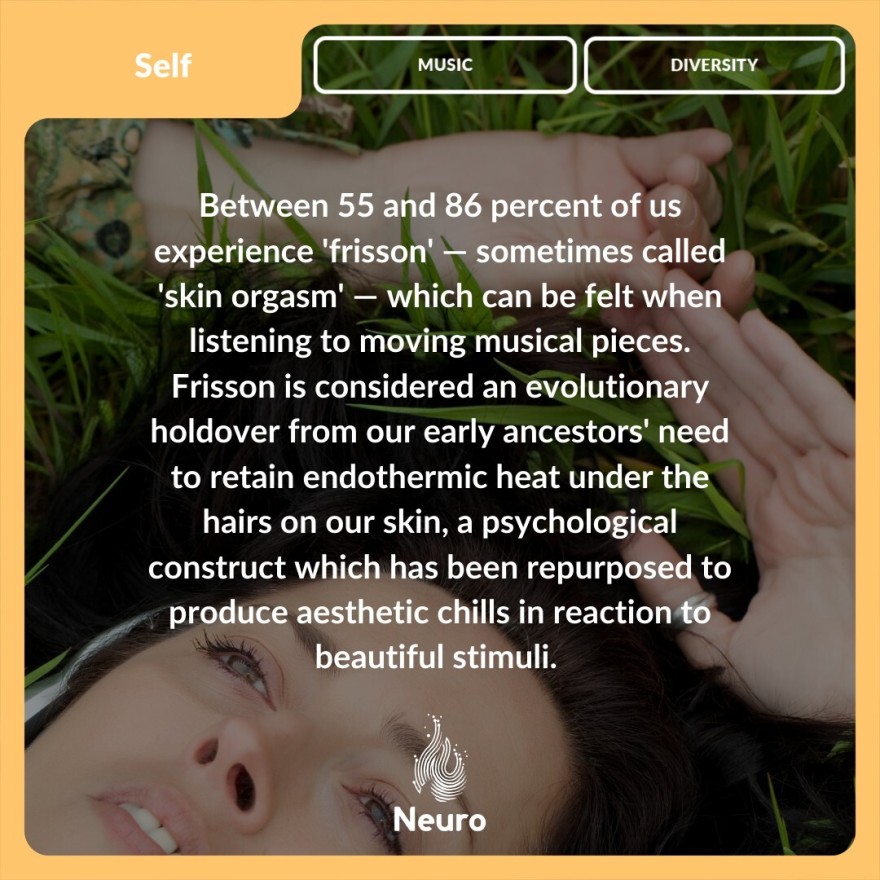What do all of the 715 songs on this free playlist have in common? https://open.spotify.com/playlist/0gUDCB11A5jL1CyLM9h1fK
They are all songs that give you the ‘chills’ – compiled by neuroscientists as a list of music that previous research has recognised as able to induce the biologist and psychological components of aesthetic chills, also known as frisson (pronounced “free-sawn”) – a pleasurable psychophysiological response which can occur in response to music listening. This phenomenon has mainly been studied in the musicology field using tonal music as an elicitor.

de Fleurian and Pearce, from Queen Mary University of London, have been studying why we enjoy listening to music by attempting to predict the occurrence of pleasurable moments in music, using behavioural, physiological, and computational methods. They analysed track-level audio features obtained with the Spotify Web API across sets of tracks to explore the features of songs that make people experience frisson. The researchers found that these songs were on average sadder, slower, less intense, and more relaxing, quiet, non-danceable, non-electric and instrumental than other songs. This latest research about frisson-inducing music indicates that computational methods have a large, untapped potential to complement empirical studies on the topic.
Previous research on frisson has been vast. A 2019 study funded by the Arts and Humanities Research Council found that a frisson can also be induced beyond the domain of music – such as by realising a deep insight or truth, reading moving poetry, perceiving beauty in nature, art, a movie, or book, or by physical contact with another person.
It’s been found that there are three distinct categories of chills: warm chills that co-occur with smiling, warmth, feeling relaxed, stimulated and happy – linked to expression of social communion and love, cold chills that co-occur with frowning, cold, sadness and anger – linked to stimuli portraying others in distress or supporting one another, and moving chills that co-occur with tears, feeling a lump in the throat, emotional intensity, and feelings of affection, tenderness and being moved – linked to having high levels of empathy.
In a paper titled ‘Knowledge, curiosity, and aesthetic chills’, published in Frontiers in Psychology journal, the author Schoeller hypothesises that frissons correspond to a satisfaction of humans’ internal drive to acquire knowledge about the external world and perceive situations and objects as meaningful. He writes, “Music recruits neural systems similar to those known to respond specifically to biologically relevant stimuli (e.g., food or sex). In terms of functional anatomy, it has been shown that aesthetic chills correlate with decreases in regional cerebral blood flow in the amygdala and hippocampus. These neural structures play a crucial role in both reward and emotions.”
Harvard researchers have also found by conducting brain scans that people who experience frisson have a much higher volume of connections between brain areas responsible for reward and emotion and the auditory cortex where sound is processed. They suggest that social–emotional communication via the auditory channel could offer an evolution basis for music-making as an aesthetic reward in humans.
Studies suggest that our earlier, hairier ancestors kept themselves warm through an endothermic layer of heat retained right beneath the hairs of their skin. The experience of goosebumps after a rapid temperature change raises and lowers these hairs to reset the layer of warmth. As clothing has now replaced the need for these endothermic heat layers, it’s been proposed that the physiological structure is still in place and has been rewired to produce frisson as a reaction to beautiful stimuli.
If you are one of the 55 to 86 percent of the human population who are lucky enough to experience frisson, you may appreciate to pause and consider how much the regard for music, beauty and meaningfulness is deeply wired into your ancient biology. Although advancing technologies may only be revealing frisson’s exact musical functions and neural mechanisms to us recently, there is poetic beauty in a human condition that shows us that having knowledge of something’s truth can happen on many levels beyond cognition.
de Fleurian, R, Pearce, M.T. (2021). The Relationship Between Valence and Chills in Music: A Corpus Analysis. i-Perception. doi: https://journals.sagepub.com/doi/10.1177/20416695211024680
Bannister, S. (2019). Distinct varieties of aesthetic chills in response to multimedia. PLoS ONE. https://journals.plos.org/plosone/article?id=10.1371/journal.pone.0224974
Schoeller, F. (2015). Knowledge, curiosity, and aesthetic chills. Frontiers in Psychology. doi: https://www.frontiersin.org/articles/10.3389/fpsyg.2015.01546/full
Sachs, M.E., et al. (2016). Brain connectivity reflects human aesthetic responses to music. Social Cognitive and Affective Neuroscience. https://academic.oup.com/scan/article/11/6/884/2223400?login=true
